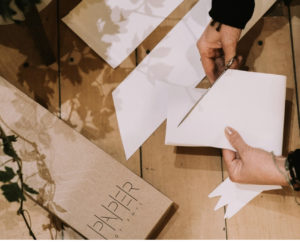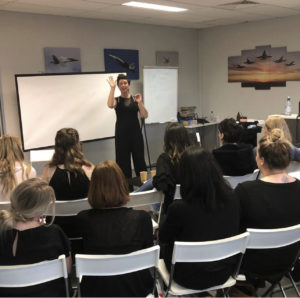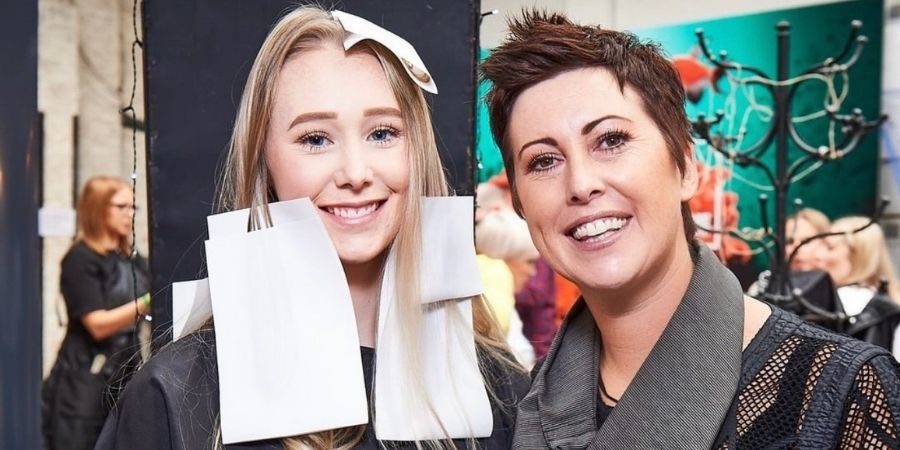How Amanda Buckingham Is Solving A Two Million Ton Waste Problem
TL.DR
• The idea for Paper Not Foil struck Amanda while wrapping her girl’s school lunches with baking paper.
• After going through a dragons den type experience with the Otago Polytechnic, they helped her get an innovation grant that kicked off a five-year research and development journey to produce a market-ready product.
• Paper Not Foil is now exporting to 14 countries across North America, Europe and even United Arab Emirates.
• Amanda has survived a business relationship with a convicted fraudster who only recently got out of jail.
• Building relationships has been the cornerstone of her and PaperNotFoil’s success.
How The Idea For Paper Not Foil Came About
It has been 12 years since the morning Amanda was wrapping sandwiches for her girl’s lunches and had the light-bulb moment tipping the $40 billion hair colouring industry on its head.
Hazel, Amanda’s youngest, had just met the world back then. Along with her two older daughters, she was balancing raising a young family and running Dunedin’s largest salon with her partner – Scott’s Base.
Amanda was growing frustrated at the ugly side of what is otherwise known as the beauty industry. As they dumped bins of waste every week, Amanda (as you do) started going through their rubbish and, to her shock, discovered – “we were going through about 2 kilometres of aluminium foil every single month – straight to the landfill.“
“There was very little opportunity to recycle at the time, and businesses back then didn’t have recycling bins like we do now. Funnily enough, we still don’t have the opportunity to recycle. People don’t understand, but most of our rubbish still goes straight to landfill”
Amanda was consumed by the thought of reducing waste over the next few months until that idea struck, “Hold on a second, maybe paper would be easier to recycle than aluminium foil“.
The next day, she put her theory to work. “I took some baking paper roll to work and tried to use it to colour hair on some mannequin heads. That didn’t work at all“.
But Amanda didn’t stop there.
Over the next few months, she used her industry connections to see what foil alternatives were on the market. After Google or her network turned up anything useful, she believed her idea had promise.
‘I’ve worked with big colour companies worldwide, so I felt that I had the background knowledge to try and find an alternative that my industry would adopt. Everyone I spoke to said they didn’t know anything else on the market. It just kept bugging me, like, I’ve got to try and do something.’
Turning The Idea For Paper Not Foil Into A Market Ready Product
An idea is one thing; bringing it to life is an entirely different story.
After looking around and weighing up her options, Amanda reached out to her local polytechnic’s innovation department to see if they could help. “I said to them I don’t know what’s involved, but I would like to try“.
The Polytech helped Amanda get an innovation grant. This was enough money to support her through their year-long dragons-dens-style product research and development program. They put her idea through intense scrutiny to explore its market viability with their product development framework.
That’s how we learnt there was nothing like it on the market – which isn’t necessarily a good thing because they questioned, “well, if no one has done it yet, then is it needed?”. That made me think about what I was trying to change and ask myself, “do I have the capacity to change an industry?”.
Perhaps just as importantly, industry reports showed a growing demand in the beauty industry for sustainable alternatives.
By the end of that year, the innovation department at Polytech was just as excited as Amanda to get this baking-paper foil alternative off the ground. “They said it was one of the most marketable products they’ve ever seen.”
It would be another four years before Amanda had something ready to bring to market.
“I was putting in 70 to 80 hour weeks. I remember days when Scott would have to take Hazel and the girls away, and I would lie in bed doing my reports on my computer because I was just f**ked. It was tough. It still is.”
First, Amanda had to find a material made from natural fibres that would behave like aluminium foil during the hair colouring process. It also had to be water-resistant, cuttable, recyclable and degradable.
She scoured Bunnings, Mitre 10, and Google until “one of the lecturers at Polytech who used to work in the printing industry asked me if I’d ever heard of a poly-paper meshed with plastic“.
“So then I started googling paper manufacturers and all the different paper types out there. I got hold of a Christchurch mill who helped me test a lot. I ended up getting in touch with an agent from Auckland who was working with this stone paper stuff, and with help from the Christchurch mill, we found something that worked.”
And the result is Paper Not Foil, a type of paper made from 89% calcium carbonate bound with biodegrading food resin glue. The hunch Amanda got from the baking paper turned out to be spot on. “I didn’t want it to have a coating or anything. The other papers they made were film coated with plastic or used plastic as the binding agent. As a consumer in the industry, I knew that wasn’t going to fly; we were actively trying to get away from plastics.“

Launching Paper Not Foil In New Zealand And Further Afield
After figuring out precisely what Paper Not Foil should be. Like, how long, how wide, sold as a roll or in a box, and getting it certified by an environmental scientist from Wanaka. Amanda was ready to go.
With a mountain of products sitting in the spare room at home, it was time to start selling. But first, she had to convince her industry they needed it.
Amanda officially introduced paper not foil to the world via her other other, job as an educator for Davines.
“It was important for me to get validation for the product from other stylists. The Polytech always said that if you can make it here, you’ll make it anywhere because New Zealand is critical of any industry changes.”
Amanda also sent samples to a list of salons she knew were trying to go green. “There was only a handful of them, but they were the adapters that went, oh this is so cool, but it’s also weird. I knew I was only going to get a small percentage of my market, but what I hoped and could see was that our industry was slowly changing towards greener alternatives.”
By whatever means necessary, Amanda just tried to put PNF in stylist’s hands early on. ‘I was just stopping on the road by any salon I came across and giving them ten pieces of paper and saying, Hey, feel this. This is what you do. Give it a crack, and I’ll give you a call in a week.’
It’s taken Amanda a lot longer than she imagined to get PNF to where it is today – stocked by distributors across the world. ‘I was a bit naive in the early days and thought people were just going to pick it up and run with it. But that doesn’t happen. Well, it didn’t happen for me anyway.’
Transitioning Paper Not Foil Into A Company And Going Global
Once just a product championed by Amanda. Paper Not Foil has transitioned into a company with an award-winning salon under its umbrella and a supporting cast of family staff and shareholders.
‘We could not have grown if it wasn’t for my PNF whanau – especially our board members, who are literally the sounding board that keeps me in check and there when I need them. Surrounding yourself with a team that brings skillsets you don’t have is soo important’
They’ve started to hit their stride after a slow start over the last 12 months. The key to this momentum is their cohesive marketing and sales approach.
Amanda phrased it as ‘going after the bottom & top’.
They tell stories about Paper Not Foil and their values on social media by creating beautiful content for their Facebook & Instagram audiences. They share results stylists achieve with their products or show how PNF is better for the environment. This gets the attention of stylists, which Amanda calls the ‘bottom‘.
While at the same time, Scott (Amanda’s husband and sales manager) is reaching out to key industry persons, such as CEOs of large distributors, on LinkedIn (i.e. the top). The hope is that by the time Scott reaches out to these people on LinkedIn, they’ve already heard of PNF through word of mouth from stylists.
Rather than going too hard for the sale on their first interaction, they’ll say something like, ‘Hey, love what you’re doing. I’m not sure if you’ve heard of us. I’m Amanda from paper not foil. I’d love to catch up with you and talk about what you’re doing.’
Their first conversations with distributors are about ‘getting to know each other’. Often they don’t even talk about working together. ‘It’s just like, Hey, what are you guys up to? Oh, my friend in Germany loves a salon that you guys supply etc. So you know it’s quite casual.’
‘The biggest thing I do personally is I Google their country’s culture before our call. Because everyone’s different, I think it’s nice to understand a little about where they’re from and how they do things in their Industry. I create a story about the distributor [in my head] before we start.’
They end their first distributor calls by saying, ‘we would love to catch up again; how would you feel if we can send you some information about PNF and give you a sample to try?.’
The product sample is followed with an email asking a little more about the distributor, like ‘Tell us about your team, where are you? Who are you selling to? We’ve got quite a few questions we ask.
At the same time, PNF’s marketing team engages the distributor and the salons they supply on social media. They share those salons’ work and talk about what the distributor is doing in the Industry. ‘We make sure they know we’re genuinely interested in working with them’.
Amanda jumps on a call with key personnel in their team and runs an education session before the samples have even arrived.

While their team is sampling PNF – Scott kicks off the contractual discussions about pricing, supplier terms, territories, and logistics. ‘It’s very fine-tuned now, but it probably still takes three months to go through that process until everything comes together at the end’.
If the two distribution agreements they’ve gotten over the line in the past 6’ish months (which could triple their business) are anything to go by, this approach works.
Amanda and her team are now selling Paper Not Foil in 14 different countries, from Greece to Canada to the UAE; they’ve spread far and wide.
Building an international company like theirs brings a unique set of challenges. More often than not, the person sitting across from them on Zoom speaks limited English, can’t point to New Zealand on a map, and operates within a completely different legal system. 3 am calls are a regular thing for Amanda and Scott.
But a shared passion for creating a greener future makes breaking down those barriers much easier. Amanda recognised this early in their journey and focused PNF’s energy on the countries ‘yelling out about sustainability.’ They’ve found more success in the Nordic region and Italy rather than looking to typical markets like the USA, Australia, and Britain.
Learning How To Sell And Mistakes To Avoid
Even though she’d spent years on salon floors and big stages at industry events, sales haven’t come naturally to Amanda.
Selling a product that no one knew anything about knocked her confidence. ‘I was always an educator – not a salesperson. But now, I’ve realised sales is simply telling your story and building a relationship. Live and breathe your elevator pitch, and someone will listen. If you’re not sure about contracts, pricing, how to pitch, put your hand up.‘
Due to Amanda’s lack of confidence and pressure to put dollars in her bank account, she used to panic. ‘When you need to make money to keep your company going, you panic.‘
Now she’s patient and waits for the right opportunities to come along. ‘You learn how much it costs when the numbers or the person you’re getting into a relationship with isn’t right.’
Amanda and PNF have adjusted their approach to selling over the past few years. They’ve found that their onboarding process is the most critical piece of the puzzle. ‘Ours used to be soo messy – I didn’t have any structure to it. Now our process flows well and is precise. All expectations are set up front, and we use stop/go points to keep the onboarding process moving. It is pretty black and white now – there are no grey areas.’
How To Find Your Next Big Business Idea
If Amanda could give any advice to people sitting at home looking for their next big idea, it would be this. ‘think about things that annoy you – what’s not working for me? What could I do better? Is there a better alternative?” And she also believes in ‘sticking with what you know.’
Amanda had built up deep industry knowledge from 20 years of working as a stylist, educator, and salon owner before embarking on her Paper Not Foil journey. She also has an impressive Rolodex of industry people she’s called on many times over the past 12 years.
But it’s more than that. ‘When you get into manufacturing and selling your product, people want to know your story. They want to know why this product resonated with you – why did you decide to do this? And I’ve got that story.’
A Run-In With A Convicted Fraudster – Why Amanda Almost Thew It All Away
It might sound like this has been a relatively smooth ride for Amanda, just lots of hard work. But that isn’t the case. ‘So there was a moment when I just about threw it all in. I did for about a week.’
Before I let Amanda tell that story, I think it’s worth noting that this cautionary tale underlines our conversation’s central theme. Relationships have built her business.
“I won’t go into too many details, but I had a business partner who ripped me off with a sort of Ponzi scheme, took all my money and ended up in jail. He even tried to sell all my IP. He left me with nothing.
Paper Not Foil (or, as it was called then, rockfoil) was very new on the market. We’d barely even started selling in New Zealand.
Having to tell your family that you’d lost all their money was pretty shit. I had to pack up my things in Christchurch and head back to Dunedin with my tail between my legs and nothing to my name.
What kept me going was I knew I had a great product, and I just kept focusing on why I wanted to do this and how important it was to help our industry change.
So I picked myself up and started again. But I had a lot of mental hang-ups from that, which I never realised until now. I didn’t realise how much it affected me. It could have destroyed me, but it didn’t thank goodness. And I tell you what. I can hand on heart say it’s the best thing that ever happened to me.”
Amanda’s biggest takeaway from that experience was not to be afraid to ask for help and talk about what you’re going through when you’re struggling. ‘Just let it out because holding it in does no good. You think you’re right. And then it will spring up, and bite you in the ass.’
Amanda’s Passion For Entrepreneurship And How That Has Helped
Successful entrepreneurs like the Elon Musk’s and Sara Blakely’s of this world talk about being obsessed with your craft. Amanda sees this a little differently. She says you need passion to succeed. And not necessarily for your company but for the cause you’re working to help.
This passion has played out positively for Amanda in many different ways.
After the fraudster setback, she kick-started Paper Not Foil in 2018 by entering a few local startup competitions to get support and funding. One of these pitches was in front of hundreds of people, and she killed it (I know because I was there).
Amanda says when you’re passionate about what you do, the stories you tell are authentic, and that’s important for connecting with people. ‘I think too many people tell stories that they take from google. Whereas if you just actually write it down, simplify it into your words and then bring your product knowledge into it. It seems to flow.’

She still gets nervous every time she goes on stage ‘it’s not easy, you know, like today I was nervous. I get nervous all the time, but I don’t think nerves are bad. They keep you on your game.’
‘Just practise a lot. I’ve made my kids, Scott, parents, and friends sit there and listen to me rant on and on. Just so that I get it all in my head. When I get nervous before a call or a presentation, I sit and shut my eyes for 5 minutes and breathe. I tell myself I’m going to feel amazing after this, and I’m going to make whoever I’m talking to feel amazing.’
Amanda also reflected on how important it has been for her and Scott to indulge in self-care. That passion can work both ways – ‘You think you’ve got to work 80 hours a week. ‘You don’t; that doesn’t help your mental capacity to deal with problems and stress.’ She recommends considering a personal coach, which is different from a business mentor – it’s someone you can share your burdens with and not feel guilty about it.
Hiring an NLP coach may sound a tad rah-rah to you, but hey, if it works, why not. ‘She gives me the tools I need to deal with stress and anxiety to think clearly and move forward in a reasonable measure, not a reactive matter.’
Amanda has found other ways to switch off too. ‘I love plants and music. Being outside in the garden, with my favourite songs on, and sipping a glass of wine is a good time. I like to sing, dance and be silly with my kids too.’
And as for what Amanda is spending her hard-earned money on. Well, sometimes, it’s the simple things in life that bring the most joy. Her best purchase in recent memory is a second-hand coffee grinder picked up for $50 from a local op-shop.
You can connect with Amanda on Linkedin or follow Paper Not Foil’s journey on Instagram.


